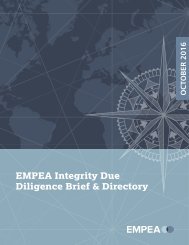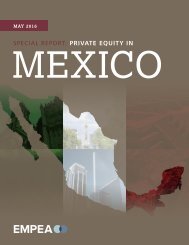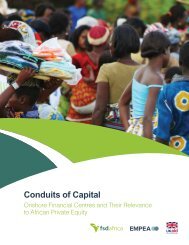MEXICO
1r3fkNK
1r3fkNK
Create successful ePaper yourself
Turn your PDF publications into a flip-book with our unique Google optimized e-Paper software.
26 | SPECIAL REPORT: PRIVATE EQUITY IN <strong>MEXICO</strong><br />
<strong>MEXICO</strong>’S REAL ESTATE SECTOR: AN ATTRACTIVE<br />
INVESTMENT OPPORTUNITY<br />
BY GREGORIO SCHNEIDER, MANAGING PARTNER & CHIEF INVESTMENT OFFICER,<br />
TC LATIN AMERICA PARTNERS<br />
The real estate asset class in<br />
Mexico has evolved over the<br />
past decade and we have seen<br />
an increase in the number of institutional<br />
players in the market,<br />
fostering a more liquid investment<br />
environment. Furthermore,<br />
Mexican real estate markets now<br />
have a deeper connection with<br />
capital markets. Since FIBRAs (the<br />
Mexican equivalent of the U.S.<br />
REIT) started in 2011, ten FIBRAs<br />
have raised funds in the capital<br />
markets with a total market capitalization of US$14.3 billion.<br />
INFONAVIT and FOVISSSTE, Mexico’s largest mortgage lending<br />
institutions, have also reached a new level of maturity, while<br />
commercial banks, most of them currently held by international<br />
firms, have aggressively increased their mortgage portfolios. In<br />
addition, we believe the asset class remains underpenetrated.<br />
Collectively, this offers an attractive risk / reward investment opportunity<br />
with downside protection supported by the value of<br />
land—a situation unique to real estate investment.<br />
We currently believe that mixed-use projects are particularly<br />
appealing. As urban populations increase and traffic worsens,<br />
proximity to local services will be advantageous. We also believe<br />
the industrial and logistics sectors in Mexico will offer compelling<br />
investment opportunities, as exports of manufactured goods to<br />
the United States are expected to increase due to a decline in the<br />
Chinese economy and better terms of trade for non-oil exporting<br />
sectors given the low energy prices and a weak currency situation,<br />
which we expect to continue.<br />
We see an opportunity in the residential segment notwithstanding<br />
the challenge of finding suitable land and developers with the<br />
adequate financial and operational structure to develop profitable<br />
projects. According to SOFTEC, a real estate consultant, and the<br />
Sociedad Hipotecaria Federal, there are close to ten million Mexican<br />
families living with inadequate housing or otherwise in a housing<br />
deficit condition. Despite government efforts, this deficit is currently<br />
growing at a pace of 750,000 additional homes annually,<br />
given insufficient new annual supply vis-à-vis incremental demand.<br />
Finally, we continue to see opportunities in for-sale greenfield<br />
projects as there is less competition from institutional capital,<br />
which is focused on income-producing assets. For-sale greenfield<br />
investment also offers the ability to execute successful exit strategies<br />
by selling to a FIBRA, capitalizing on both situations. We<br />
estimate that the size of the investment opportunity for all greenfield<br />
development projects in Mexico ranges from US$3 billion<br />
to US$6 billion annually, based on construction loans granted in<br />
2014 of approximately US$18 billion. The investment opportunity<br />
for greenfield development in Mexico could reach up to US$25<br />
billion across all real estate sectors (i.e., residential, industrial and<br />
commercial) if we include debt in addition to equity investments.<br />
Mexico mirrors the United States in the late 1940s in terms of<br />
size, population and education levels. As stated by SOFTEC, most<br />
countries that reach Mexico’s current level of GDP per capita<br />
double their income in 20 years, as evidenced by Austria, Belgium<br />
and South Korea, among others, which, like Mexico, expanded<br />
their economies based on manufactured exports and witnessed<br />
the rise of a robust middle class. Going forward, we expect a<br />
convergence to the state of affairs in the United States, with specialized<br />
players and new, more sophisticated instruments arising.<br />
Mortgage securitization (RMBS and CMBS) is yet to become a<br />
reality and, if well managed, will bring additional liquidity to the<br />
real estate sector.<br />
The key factors that will drive continued growth of real estate in<br />
Mexico include the underinvestment in this segment, the broad<br />
housing deficit, demographic pressures, expansion of the middle<br />
class, increased liquidity in the markets and recent reforms to the<br />
energy and telecommunications sectors, which are expected to<br />
boost the growth of the economy. The country’s real estate sector<br />
is still underdeveloped relative to developed economies, with<br />
mortgages outstanding close to 10% of GDP (versus 50-80% in<br />
developed markets). The aforementioned conditions make Mexico<br />
an attractive market and one of the most compelling environments<br />
for investment available today.





